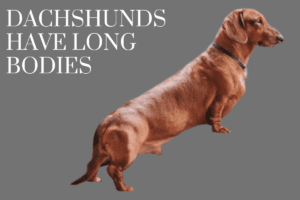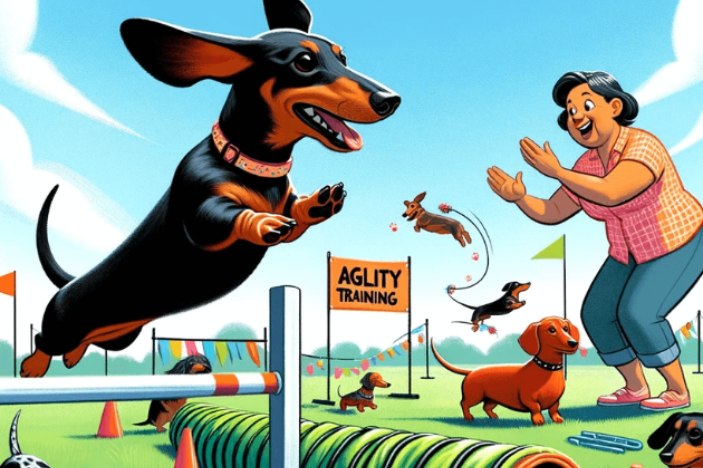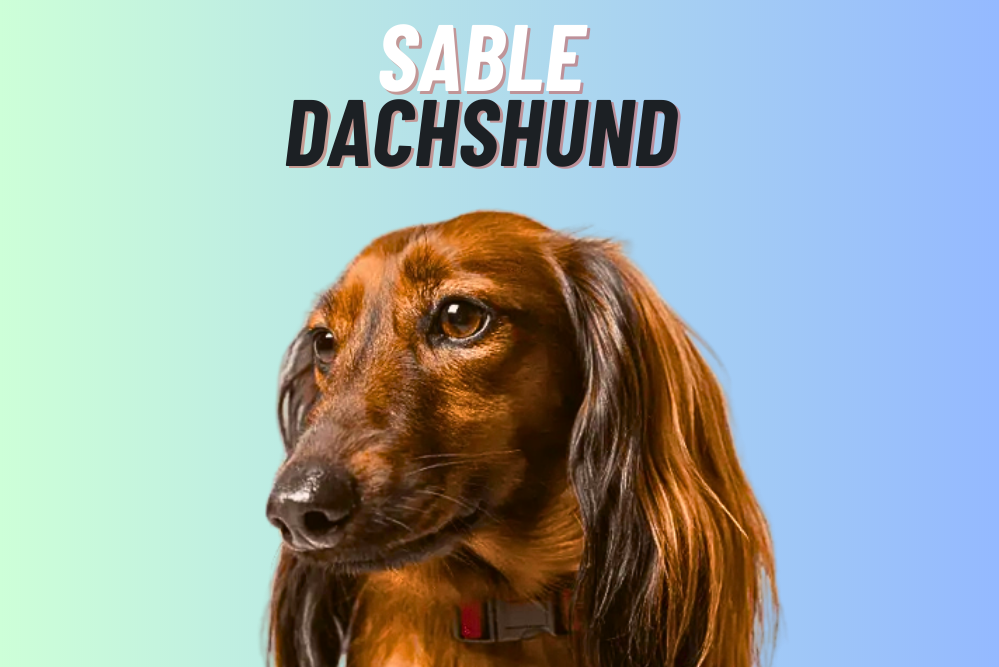Dachshunds Long Bodies
Dachshunds have long bodies primarily due to their genetic makeup and selective breeding. The unique physical characteristic of their elongated bodies is a result of selective breeding to fulfill a specific purpose.
Dachshunds were originally developed in Germany several centuries ago for hunting small game, particularly badgers. Their long bodies allowed them to enter burrows and tunnels in pursuit of their prey.
The elongated shape was advantageous for navigating tight spaces underground and giving them an edge in their hunting abilities.
Through selective breeding, individuals with longer bodies were favored to maintain and enhance this hunting trait.
Over time, this selective breeding resulted in the distinctive appearance of the modern Dachshund breed, characterized by their elongated bodies, short legs, and long snouts
Why do Dachshunds have long snouts?
Dachshunds have long snouts primarily because of their breeding history and their original purpose as hunting dogs.
The elongated snout, also known as a muzzle, is a feature that has been selectively bred to serve specific functions.
As hunting dogs, Dachshunds were used to track and chase burrowing animals such as badgers, rabbits, and foxes.
Their long snouts helped them in locating and pursue their prey by providing an enhanced sense of smell and allowing them to pick up scent trails more effectively.
The elongated snout contains a larger surface area for olfactory receptors, enabling Dachshunds to detect and follow scents with greater precision.
Selective breeding over generations has resulted in the elongated snout becoming a characteristic feature of Dachshunds.
Breeders favored individuals with longer snouts to maintain and enhance their hunting abilities. While the elongated snout is no longer essential for their current role as companion animals, it remains a distinctive trait of the breed.
It’s worth noting that the long snout can also contribute to certain health issues in Dachshunds. Some dogs with elongated muzzles may be prone to respiratory problems, such as brachycephalic airway syndrome.
Responsible breeders aim to prioritize the health and well-being of Dachshunds, taking steps to minimize the risks associated with certain physical characteristics.
Why do Dachshunds have short legs?
Dachshunds have short legs as a result of selective breeding for their specific hunting purpose and the desire to create a dog that could excel in certain environments.
The short legs of Dachshunds are an adaptation that allows them to navigate and maneuver efficiently in tunnels and burrows while hunting.
This breed was primarily developed to hunt small game, particularly badgers, which reside in underground burrows.
The short legs enabled Dachshunds to enter these narrow tunnels and move easily through them, giving them an advantage in reaching and confronting their prey.
Over time, through selective breeding, individuals with shorter legs were favored to maintain and enhance this trait.
Breeders aimed to create dogs with the ideal combination of a long body and short legs, allowing them to excel in their hunting abilities.
It’s important to note that the short legs of Dachshunds can also contribute to some health concerns. Their body structure puts strain on their spine, which makes them more susceptible to issues like intervertebral disc disease.
Responsible breeding practices focus on minimizing the risk of such health problems by prioritizing the overall health and well-being of the breed.
Do Dachshunds have long tails?
Dachshunds can have varying tail lengths depending on their individual genetics and breed standards. There are two main types of tail lengths seen in Dachshunds: long tails and short tails.
Long-tailed Dachshunds have tails that are proportional in length to their body size. These tails are typically slender and extend past the base of the spine.
Long tails are more common in Dachshunds found in countries where docking (surgical removal of the tail) is less common or prohibited.
On the other hand, short-tailed Dachshunds are those that have had their tails surgically docked. Tail docking involves the removal of a portion of the tail, usually when the puppies are just a few days old.
This practice has historically been more prevalent in certain countries and was often performed to prevent tail injuries in hunting dogs or for aesthetic purposes.
Do Dachshund’s Long Bodies Hurt Them?
Dachshunds’ long bodies can potentially pose health risks and lead to certain issues, although not all Dachshunds will experience them.
The elongated body structure of Dachshunds can make them more susceptible to certain health conditions, particularly those related to their spine.
One common issue in Dachshunds is intervertebral disc disease (IVDD). IVDD occurs when the discs between the vertebrae of the spine degenerate or become herniated, leading to pain, nerve compression, and mobility problems.
The long back and relatively short legs of Dachshunds can put additional strain on their spinal column, making them more prone to IVDD.
To minimize the risk of spinal problems, it is important to take certain precautions and provide appropriate care for Dachshunds:
- Weight management: Maintaining a healthy weight is crucial for Dachshunds to reduce stress on their spine. Obesity can exacerbate existing spinal issues or increase the likelihood of developing them.
- Proper exercise: Regular exercise is important to keep Dachshunds active and prevent weight gain. However, activities that involve excessive jumping or activities that put a strain on their backs should be avoided or minimized.
- Supportive environment: Providing Dachshunds with supportive surfaces to rest on, such as orthopedic beds, can help reduce pressure on their spines.
- Regular vet check-ups: Regular veterinary check-ups are essential to monitor the overall health of Dachshunds and address any potential spinal issues early on.
It’s also important to note that responsible breeding practices aim to minimize the risk of health issues in Dachshunds, including those related to their body structure.
Reputable breeders prioritize the health and well-being of their dogs and take steps to minimize the occurrence of genetic conditions.
By being aware of the potential health risks and providing appropriate care, Dachshund owners can help mitigate the impact of their long bodies on their overall well-being.
Why do Dachshunds have floating shoulders?
Dachshunds are known for their unique physical feature called “floating shoulders,” which refers to the appearance of their shoulder blades being unattached or loosely attached to the ribcage.
This characteristic allows their front legs to move more freely and contributes to their distinctive gait. The presence of floating shoulders in Dachshunds is a result of their breeding history and body structure.
When Dachshunds were originally developed as hunting dogs, their body shape was selectively bred to optimize their ability to hunt and burrow.
The loose attachment of the shoulder blades allows for increased flexibility and range of motion in their front legs, enabling them to navigate tight spaces and dig efficiently.
The floating shoulders give Dachshunds an enhanced ability to maneuver underground and navigate through burrows, which was crucial for their role in hunting small game like badgers.
This characteristic is considered a breed-specific adaptation that has been maintained and perpetuated through selective breeding over generations.
It’s worth noting that the term “floating shoulders” is more of a descriptive term and doesn’t mean that the shoulder blades of Dachshunds are completely unattached.
Rather, it refers to the relatively loose or flexible attachment compared to some other dog breeds. While floating shoulders are characteristic of Dachshunds, they don’t typically cause any health issues or concerns.
However, it’s important to remember that individual Dachshunds may still be susceptible to other health conditions related to their body structure, such as intervertebral disc disease, which is more common in this breed due to their long bodies.
Conclusion
Dachshunds have long bodies as a result of their breeding history and specific purpose as hunting dogs.
The elongated body structure, with its unique combination of a long spine and short legs, provided Dachshunds with the ability to enter and navigate underground tunnels and burrows in pursuit of their prey.
Through selective breeding, individuals with longer bodies were favored to maintain and enhance this hunting trait.
While the long body shape is a defining characteristic of Dachshunds, it can also contribute to certain health concerns.
Their elongated spines can make them more prone to conditions like intervertebral disc disease. However, responsible care and breeding practices can help minimize these risks.
It is important for Dachshund owners to be aware of the potential health issues associated with their long bodies and take appropriate measures to support their overall well-being.
Maintaining a healthy weight, providing proper exercise, and offering a supportive environment can help mitigate the impact of their body structure on their health.
Despite the potential health risks, Dachshunds continue to be beloved and popular companions. Their long bodies, paired with their charming personalities, make them unique and endearing pets.
By understanding the origins and characteristics of their long bodies, Dachshund owners can provide the care and attention necessary to ensure their pets lead happy and healthy lives.




